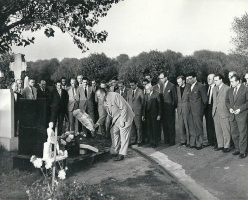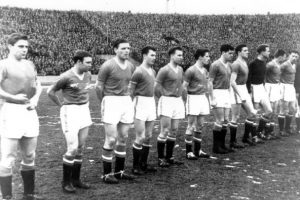Ask a Manchester United supporter to name one of the players who died in the Munich air disaster and they would more than likely say Duncan Edwards, not Eddie Colman.
Former teammate and friend Wilf McGuiness said of Edwards; “Take the best of, say, Roy Keane, Bryan Robson, Steven Gerrard and Cesc Fabregas, all rolled into one, without any bad temper or anything, and that was Duncan Edwards.”
But in amongst the tragedy of British European Airways Flight 609 on the 6th of February 1958 was a Salford lad, Eddie Colman, whose right-side partnership with Edwards remains, like all the lost Busby Babes, the stuff of legend.
‘Snakehips’ Eddie Colman
Born in Ordsall in 1936, Eddie’s dad, Richard, was also a footballer. Almost as soon as he had left school, where he was a regular in the schoolboys team, he was snapped up by Matt Busby’s Manchester United.

Eddie Colman. Credit: Manchester United
During his youth. he was a member of Salford Lads’ Club.
Today we remember Eddie Colman,former member & 21yr old Manchester United star who died in the Munich air disaster 60yrs ago.Eddie is remembered by senior volunteers who attended the annual camp in 1951 (centre,middle row)&played in the same 3rd Division jr football team (centre) pic.twitter.com/ShC2sjfn4a
— Salford Lads’ Club (@salfordladsclub) February 6, 2018
After leading United’s youth team to three consecutive FA Youth Cups, he finally made his first-team debut, against Bolton in November 1955.
Once in the first team, Colman hardly ever left, securing a league title at the end of that season, and helping United to retain the championship the following season.
His slaloming style of dribbling earned him the nickname ‘Snakehips’ among teammates and supporters, including his friend and partner Edwards.
He was part of the United sides that lost in the FA Cup final in 1957 and reached the European Cup semi-finals in the same year.
And it was after a European Cup game that the fateful plane crash occurred.

Colman was the youngest of the eight United players to die that day, at 21 years and three months. By that time, he had already made over 100 appearances for United.
Legacy
A Salford University accommodation building still bears his name, and his grave lies in his home city as well.
McGuiness described Colman as “a chirpy lad and a terrific player”. And he was surely a future England international, he would have been 29, in his prime, by the time the 1966 World Cup came around.
The Flowers of Manchester live on forever, but the tragedy lies in how much this Salford flower could have blossomed.
















3 Comments